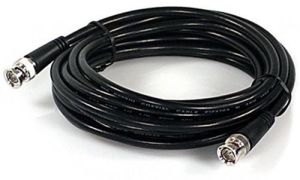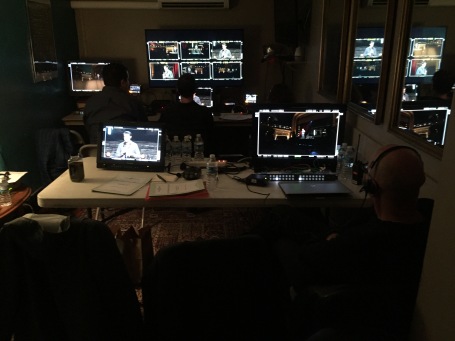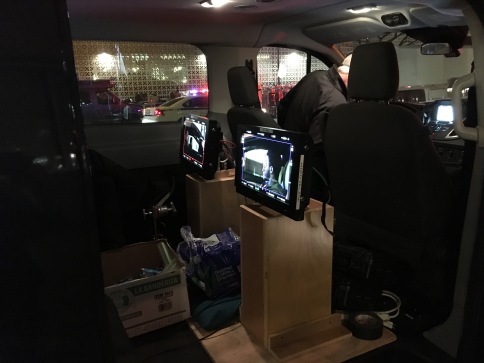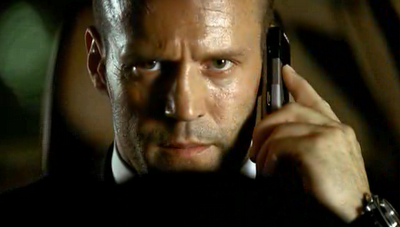A while back I wrote an article about “grips,” one of the first film credits the average movie goer puzzles over. But gripping isn’t my day job. I’m usually a video assist operator. Most people, even my coworkers, don’t really know what video assist entails. Well hold onto your BNC*, because you’re about to find out!

The Basics
Do you ever watch the bonus features at the end of a movie and see the director watching a television monitor? That’s video assist. The video assist operator sets up that monitor. Pretty basic. More broadly, it’s the video assist operator’s job to get the image from every camera (no matter how many there are or where they are) to the director. In a nice, studio setting, it may look something like this.

This is a control room we built for Comedy Central. On a stage, with one camera, this may be as simple as connecting the camera to a monitor (with some BNC). Things get a little more complex if you’re riding around the street at seventy miles an hour or if one of your cameras is in a helicopter. In those situations, we use transmitters to get the image from the camera to the director.



History
Once upon a time, we filmed on something called “film.” This was a roll of cellulose coated with a film of photo reactive chemicals that had to be developed before you could see what you shot. Each day, someone would run the film to a lab where it was developed. Then they would race back with “dailies” for the director and producer to review. It worked great for about 70 years.
But in the 1950s, television and video came onto the scene. Television captured images electronically and recorded them onto magnetic videotape so there was no need to “develop” film. Although the quality was far inferior to film, people could now watch what they filmed immediately after they filmed it.
In 1960, Jerry Lewis used this new technology for his film The Bellboy. As both the director and the star, he couldn’t watch his own performance. He connected a video system to the film camera allowing him to instantly playback what was just recorded and make adjustments to his performance. This is generally considered the invention of video assist** and the first use of video playback.

Playback
In addition to getting the image to the director, the video assist operator records the action, allowing for immediate playback. This allows directors to re-watch takes without waiting for dailies. Directors may call for playback to check performances, look for continuity errors, see if a piece of gear was in the shot, check to make sure a stunt or effect worked, or watch something back in slow motion.
The video assist system is also used to record rehearsals. When we shot on film, this was a critical way to practice camera and actor movement without wasting thousands of feet of film. Today, most film production is done on digital video, but film crews still use rehearsals to practice shots before all of the lights, makeup, and effects are in their final places.
On a one-day shoot for a thirty-second commercial, playback may not be critical. But on something like a feature film that may take months and is generally not filmed in chronological order, playback can play a major role in keeping a film’s continuity. One intern I worked with said that video assist sounded like the film’s library. I kind of like that. (To be fair, the script supervisor is the film’s librarian, the video assist operator is the guy who has to go to the basement and find all of the old reference books…)
It’s important to point out that video assist is for reference only. When we shoot on film, the video feed or “tap” doesn’t have nearly the depth of field or exposure range of a piece of film. Video playback is not a completely accurate representation of what you filmed. In fact, oddly enough, video taps only record what isn’t on the film. The light entering the camera either exposes the film or goes to the video tap. Most things happen so quickly it doesn’t really matter. But several years ago, I was working with a producer to film gunshots for an action movie. When I played it back for him, he didn’t see the muzzle flash. I had to explain to him that was a good thing because it meant the muzzle flash was on the film. (Ugh. Tech talk.) And while that’s not the case with modern digital cameras, the video feed is a compressed version of what you’re actually recording. Much to the dismay of one producer whose intern deleted their favorite take, video assist operators do not record full resolution video files.
One other note is that for decades, video was recorded on tape. This led video assist operators to also be called video tape recorders or VTR. And while many ADs will still stay “let’s roll video” we moved on to computers about ten years ago.
Sync
In addition to the image, the video assist operator works with the sound department to get audio to the director. It’s critical to make sure all of the cameras and the audio are synchronized. Like watching a badly dubbed film, it’s disorienting and distracting to watch things out of sync.
This may sound like a simple thing, but let me give you an idea of what it’s worth to a production. A few years ago, shortly after we switched to high definition signals, quality, affordable transmitters were still in development. The transmitters we used, while great at long distances had a noticeable delay. (It takes some time to crunch down all of that video data, shoot it through the air, and unpack it back into an image.) This isn’t an issue if you’re filming across a football field. It is if you’re sitting ten feet from your actor and the actor on your television is moving noticeably slower. So after one frustrating day of filming on a new television show with transmitters that were less than a year old, our company shelled out $40,000 to upgrade to the latest transmitters.
Gak
Gak is a technical film term for stuff. And video assist operators have a lot of gak: monitors, switchers, speakers, cable, transmitters, hard drives, HDMI, BNC, barrels, patch bays, UPS’s, power conditioners, batteries, power cables (OSHA cords, P-Tap, Lemo, Hirose, 4-pin XLR), 3-pin XLR, mini XLR, intercoms, video printers, and on and on and on. Again, all of this is to get the image from the camera or cameras, synchronize it with the audio and give it back to the director for live viewing and playback.


It’s a lot of techno-wizardry and it can be kind of mesmerizing. Maybe that’s why everyone likes to look over your shoulder. Or maybe they just like watching TV. Whatever the case, the video monitors always attract a crowd. The director, assistant director, and script supervisor are generally at the monitor. The producers will often get their own set of monitors. Then there are the hair, makeup, and costume people who need to be sure the actors look their best. And you’ve got the additional assistant directors cueing background actors, the electric and FX department standing by for cues, the humane society looking out for their four legged actors, and a couple of groupies for good measure.
And of course, all of these people need chairs and coolers and tents and heaters if it’s cold and, frankly, before you know it, you’ve got a regular village on your hands: a video village, which has become the industry term for, well this.

One of the biggest positives about video assist, however, is that you always want to be near the director. So if it’s raining, you’ll be dry. If it’s cold, you’ll be warm. If it’s warm, you’ll be cool. And you’re generally the first person to know if craft service is serving something better than hot dogs.
24 Frame Playback
Video assist operators have one more vital function that isn’t related to anything else I’ve mentioned so far. We are responsible for every “on-screen” video display. Every time you see a smart phone or a television or a computer monitor, a video operator has provided that image. Here are a few of the riveting images I’ve put on screens.


Amazing stuff, right? The video operator works in conjunction with the director, props department, and editor or visual effects department to make sure the right images get on the right monitors. Sometimes, that image doesn’t exist yet, so we just put green or grey screens on the monitors. That helps the VFX department create the image in post. Green makes it easier to remove the image. Grey allows light to fall on the set and actors like a real television.
Video assist operators need to be careful about what they put on screen. One of my coworkers was troubleshooting an issue with his personal phone and forgot to delete the number when we went to shoot. Months later when the DVD came out, he was inundated by calls from curious fans who wanted to know who Jason Statham called in the middle of the film

The name, “24 frame playback” comes from the fact that film cameras used to film 24 frames or individual pictures a second. Televisions, however, display 29.97 pictures a second. So for every 1 picture a film camera takes, a television displays 1 ¼ pictures. (Oh God. Math…) Because the television is projecting light, that means ¼ of the television screen will appear brighter than in every picture the film camera takes. That’s why in old movies, you will see television screens flickering in the background. To fix that, playback operators force the television to display images at 24 frames, not 30.
Modern TVs and flat screens like your phone don’t display images the same way older TVs did, so we don’t actually need to create a 24 frame video. That’s why it’s anachronistic to call it “24 frame playback” when it’s no longer 24 frames and playback actually has another meaning. Sheesh.
For some more information about how a television actually works, check out this fascinating video from The Slow Mo Guys.
Roll the Credits
There you have it. Another one of those hundreds of names that scroll by at the end of a movie explained. While it’s true that most of the work of the video assist operator doesn’t end up one screen, the movie – and filmmaking – wouldn’t be the same without them.
*BNC, the ubiquitous tool of the video assist operator, is a type of connector for video cables. BNC is also refers to the cable itself. Many people erroneously think it stands for “British Naval Connector,” a rather shoddy backronym for an American invention. It actually stands for “Bayonet Neill-Concelman,” the connecting mechanism and the name of its inventors.
**Parts of the video assist system existed before this and several technicians improved the system over time. You can read more about that here: https://www.cnet.com/news/video-assist-predates-jerry-lewis-patent/

Hey man! Excellent write up! I always have a hard time explaining to people what exactly it is that I do…
-video assist guy in San Francisco
LikeLike
Thanks! I’ve always found it hardest to explain to producers. “You’re sure you want to cut me early? If I leave, I’m taking all my toys with me…”
LikeLike